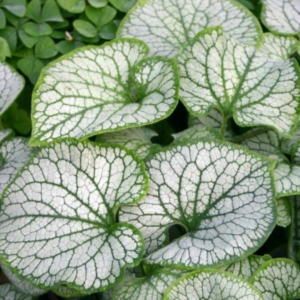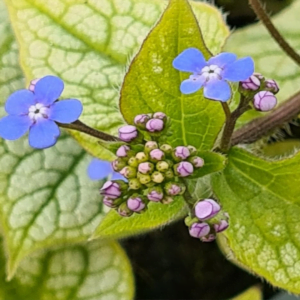Introduction
Brunnera macrophylla, commonly known as Siberian Bugloss or False Forget-Me-Not, is a stellar addition to any garden. This detailed review aims to provide avid gardeners and enthusiasts with comprehensive insights into caring for this charming perennial. Famous for its heart-shaped leaves and delicate blue flowers, Brunnera macrophylla not only brings aesthetic pleasure but also serves as a resilient and low-maintenance choice for varied garden landscapes.
we will delve into every aspect of Brunnera macrophylla care, emphasizing its ease of cultivation and the joy it brings to gardens. From the basic plant care to more advanced topics like overwintering and propagation, this guide serves as your one-stop resource. Let’s embark on this green journey and discover why Brunnera macrophylla is a must-have in your garden.
Outdoor Plant Details Brunnera macrophylla:
| Key Specifications | Details |
|---|---|
| Common Names | Siberian Bugloss, False Forget-Me-Not, Heartleaf Brunnera |
| Botanical Name | Brunnera macrophylla |
| Family | Boraginaceae |
| Plant Type | Perennial |
| Mature Size | Typically 12-18 inches in height and width |
| Sun Exposure | Partial to full shade; tolerant of morning sun |
| Soil Type | Moist, well-drained, rich in organic matter |
| Soil pH | Slightly acidic to neutral (pH 6.0 to 7.0) |
| Snow Surviving | Tolerates snow; benefits from snow as an insulator |
| Bloom Time | Spring |
| Flower Color | Mostly shades of blue, some varieties have white or pink |
| Hardiness Zones | USDA zones 3-8 |
| Native Area | Eastern Europe and North West Asia |
| Benefit | Low maintenance, deer-resistant, attractive foliage and blooms |
The key specifications of Brunnera macrophylla, providing a quick and comprehensive reference for gardeners and plant enthusiasts.
Plant Care
Brunnera macrophylla is a testament to both beauty and resilience. It thrives with minimal fuss, making it ideal for both novice and experienced gardeners. Key to its care is understanding its preference for cooler conditions and moderate moisture.
Sun Exposure
This plant revels in dappled shade. Too much sunlight can scorch its leaves, while too little can diminish its vibrant blooms. The perfect balance is found in a spot that receives morning sun and afternoon shade, ensuring a display of its quintessential blue flowers each spring.
Soil
Brunnera macrophylla is not particularly fussy about soil, but it does best in well-draining, rich loamy soil. A pH ranging from slightly acidic to neutral is ideal. The soil should retain moisture without becoming waterlogged, which can lead to root rot.
Water
Consistent moisture is key, especially during dry spells. Weekly watering helps maintain the right moisture level, but it’s crucial to adjust based on rainfall and temperature. Overwatering or poor drainage is a nemesis for its roots.
Temperature and Humidity
This plant favors cooler temperatures and can struggle in hot, humid conditions. It is hardy in USDA zones 3-8, showcasing its adaptability to various climates. In areas with high humidity, ensuring good air circulation is vital to prevent disease.
Snow Survivability
A blanket of snow can be a friend to Brunnera macrophylla. It provides insulation against bitter cold and temperature fluctuations. However, in regions with heavy snowfall, some protection like mulch or a burlap cover can prevent damage to the crown.
Pruning
Pruning is more about aesthetics than necessity. Deadheading after blooming encourages foliage growth and maintains its tidy appearance. Cutting back in late fall or early spring keeps it rejuvenated and ready for new growth.
Overwintering
In colder regions, overwintering involves a layer of mulch to protect the roots. This practice shields the plant from freeze-thaw cycles that can heave and damage the root system.
Fertilizer
A light application of a balanced, slow-release fertilizer in early spring can give Brunnera macrophylla a boost. However, it’s a low feeder, and over-fertilization can do more harm than good, leading to weak growth and fewer blooms.
Propagating Plant
Propagating through division is simple and effective. Dividing the plant every 3-4 years in early spring or fall not only propagates it but also rejuvenates older plants, ensuring vigorous growth and flowering.
Types of Brunnera macrophylla
Brunnera macrophylla boasts several stunning cultivars, each with unique characteristics that cater to different aesthetic preferences:
- ‘Jack Frost’: Celebrated for its silvery leaves with green veins and edges, it brings a luminous quality to shady areas.
- ‘Variegata’: Features leaves edged in white, adding a striking contrast to darker foliage plants.
- ‘Dawson’s White’: Distinguished by its bold white edges and green center, it’s a vivid addition to any garden.
- ‘Hadspen Cream’: This variety offers a softer touch with cream edges, blending well with other shade-loving perennials.
Each type shares the core attributes of Brunnera macrophylla but adds its own flair, allowing gardeners to choose based on their landscape design and personal preferences.
Common Pests & Plant Diseases with Solution
Despite its hardiness, Brunnera macrophylla can encounter pests and diseases:
- Slug and Snail Damage: These pests are attracted to the tender leaves. Solution: Use slug baits or barriers like eggshells or diatomaceous earth around the plant.
- Foliar Diseases: Leaf spot and rust can occur, especially in humid conditions. Solution: Improve air circulation and avoid overhead watering. Fungicides can be used as a last resort.
- Crown Rot: Overly wet conditions can lead to root and crown rot. Solution: Ensure good drainage and avoid overwatering.
Regular monitoring and prompt action can prevent these issues from becoming serious problems.
How to Get the Plant to Bloom
To encourage robust blooming in Brunnera macrophylla:
- Proper Light: Ensure it’s planted in an area with appropriate light – morning sun with afternoon shade is ideal.
- Soil Fertility: Maintain a nutrient-rich, well-draining soil. Over-fertilization can harm blooming, so balance is key.
- Pruning: Deadhead spent blooms to promote more flowering.
- Watering: Consistent moisture, especially during dry periods, can boost flower production.
Following these practices will help ensure a delightful display of blooms each spring.
Common Problems With Plant
Some common issues with Brunnera macrophylla include:
- Leaf Scorch: Occurs in too much sun. Solution: Plant in shadier areas or provide afternoon shade.
- Leggy Growth: Can happen in too much shade. Solution: Increase light exposure slightly.
- Yellowing Leaves: Often a sign of overwatering or poor drainage. Solution: Improve soil drainage and adjust watering practices.
Understanding these problems and their solutions ensures your Brunnera macrophylla remains a healthy and attractive component of your garden.
Gardener’s Reflection: A Testament to Nature’s Splendor
In conclusion, Brunnera macrophylla epitomizes the joy and beauty of gardening. Its ability to thrive with basic care, combined with its stunning foliage and delicate blooms, makes it a treasure in the shade garden. This perennial reminds us of the resilience and adaptability of nature, inviting us to create a harmonious and tranquil garden space. As gardeners, nurturing Brunnera macrophylla becomes not just a task, but a journey of connecting with nature’s intricate patterns and cycles.
Quickly Declining: Signs and Solutions
Recognize signs like yellowing leaves, stunted growth, or fewer blooms. These can indicate issues with watering, soil condition, or pests. Addressing these problems early can save the plant and restore its beauty.
Gardener’s Reflection: More than Just a Plant
In conclusion, Brunnera macrophylla is not just a plant; it’s a testament to nature’s resilience and beauty. Its low-maintenance character, coupled with its stunning foliage and flowers, makes it a cherished addition to any garden. This perennial reminds us that beauty often lies in simplicity and that even in the most understated forms, there can be a wealth of wonder and enjoyment.
Frequently Asked Questions
Decode the magic of gardens with our guide to Landscaping Styles Frequently Asked Questions.
- Water it weekly, adjusting based on rainfall and temperature. The soil should be moist but not waterlogged.
- It prefers partial to full shade. Too much sun can scorch its leaves, so it’s best in a spot with morning sun and afternoon shade.
- Yes, it’s known to be deer-resistant, making it a great choice for gardens in areas with a high deer population
- Propagate by division in early spring or fall. This not only creates new plants but also rejuvenates the old ones.
Recent Posts
- Modern Mural Ideas Transforming Walls into Artworks
- Thematic Table Decor Dressing Your Table for Special Occasions
- Festive Lighting Ideas Brightening Your Home for the Holidays
- Biodegradable Decor Materials Choosing Earth-Friendly Options
- Personalized Space Decor Making Your Home Uniquely Yours
- New Year’s Eve Decor Ringing in the New Year in Style
- Transforming Junk into Decor Upcycling at Its Best
- Second-Life Decor Objects Giving Old Items New Purpose
- Unique Decoration Crafting Standout Ideas for Your Home
- Environmentally Friendly Styling Decor with a Conscience











